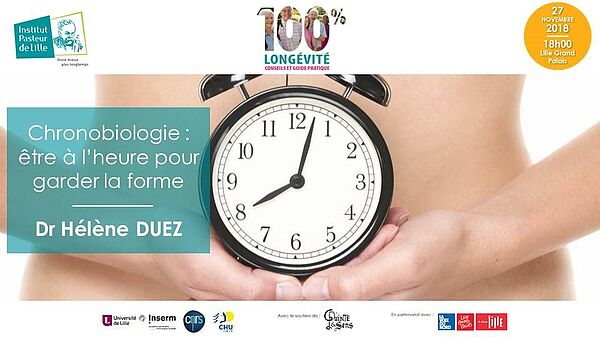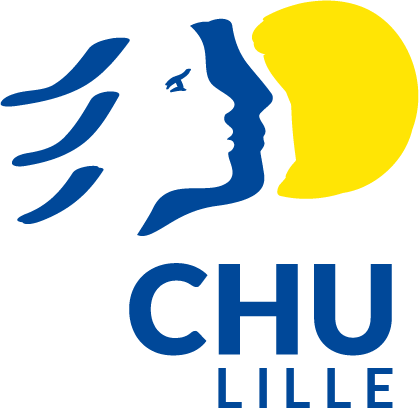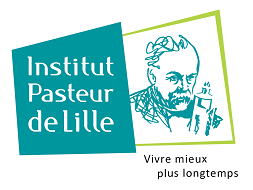Topic 5: Nuclear receptors in the circadian rhythm

Contact info:
INSERM U1011 – Institut Pasteur de Lille-Université Lille Nord de France – EGID
1 rue Calmette, BP245, 59019 Lille
Tel: +33(0)3.2087.7793
Email : helene.duezpasteur-lille.fr
Oricd Id : 0000-0002-4130-7987
Keywords: Circadian rhythms, Rev-erb, metabolic and cardiovascular disorders, myopathies, skeletal muscle, liver and adipose tissue, vascular wall, immune cells, mitochondria
-
Interest of the research :
The biological clock is an ancient molecular circuit that allows the body to anticipate predictable daily changes and optimise its functions by matching them to the most relevant time of day. The ubiquitous role of the clock in all facets of physiology is illustrated by the fact that disruption of the clock leads to numerous pathologies ranging from metabolic and cardiovascular diseases to immune disorders or cancer.
However, in our modern '24/7' society, physical activity, diet and light exposure are no longer restricted to the hours of the day, sleep duration has been drastically reduced over the last century and shift work is imposed by economic demand, leading to circadian misalignment - the desynchronisation between intrinsic circadian rhythms (biological rhythms) and behavioural cycles - and putting millions of people at increased risk of developing serious diseases.
The mammalian molecular clock consists of several transcription factors. Among them, the nuclear receptors Rev-erbα and Rev-erbβ, and RORα are of particular interest because they can be bound and activated by small molecules, thus representing pharmacological targets for realigning the clock.
By focusing on Rev-erbs and RORs, our goal is to elucidate the cellular and molecular mechanisms by which the clock impacts metabolism and immunity in several pathophysiological contexts, in particular metabolic, cardiovascular and muscular diseases. We also seek to determine whether and how pharmacological modulation of these nuclear receptors prevents clock disruption or restores circadian rhythmicity in genes/proteins/inflammatory mediators/metabolites and ameliorates these pathological conditions.
-
Our recent findings:
Ø We found that Rev-erb-α controls pro-inflammatory cytokine secretion in macrophages through rhythmic repression of the NLRP3 inflammasome pathway, identifying Rev-erb-α as a major player in so-called circadian immunity (Pourcet, et al., Gastroenterology, 2018).
https://www.ncbi.nlm.nih.gov/pubmed/29277561
Ø We have shown diurnal variations in perioperative myocardial injury in patients undergoing aortic valve replacement, and that modulation of Rev-erb-α could be cardio-protective (Montaigne et al., Lancet, 2018).
https://www.ncbi.nlm.nih.gov/pubmed/29107324
Ø We discovered how the circadian clock controls muscle biogenesis and mitochondrial function, as well as autophagy (Woldt, Sebti et al., Nature Medicine, 2013, 19(8): 1039-46).
http://www.ncbi.nlm.nih.gov/pubmed/23852339
Ø In collaboration with Profs. Patrick Schrauwen and Matthijs Hesselink, we published the first evidence that mitochondrial function oscillates throughout the 24-hour cycle in human myotubes, and that clock gene oscillations are impaired when myotubes are isolated from diabetic patients (van Moorsel et al., Mol Metab 2016; Hansen et al., Sci Rep 2016). More recently, we have shown, together with Profs. Schrauwen, Hesselink and Scheer, that circadian misalignment in healthy young lean men compromises insulin sensitivity of skeletal muscle (Wefers et al., PNAS, 2018), suggesting that impaired skeletal muscle clock function may contribute to the increased risk of type 2 diabetes observed in shift workers.
Ø We showed that Rev-erbα deficiency leads to muscle atrophy, whereas administration of a Rev-erb agonist reverses dexamethasone-induced muscle atrophy, identifying Rev-erb-α as a promising target to limit muscle loss (Mayeuf-Louchart, Thorel, et al., Sci Rep 2017).
Ø In collaboration with Prof. M. Lefranc, we established a mathematical model of clock disruption associated with metabolic disorders defined by low amplitude and shifted circadian expression of metabolic sensors and genes (Woller et al., Cell Reports, 2016).
Ø In collaboration with Drs A. Danckaert and F. Chrétien (Inst Pasteur Paris), we have developed a new bioinformatics tool (MuscleJ) that quantifies muscle fibre cross-sectional area, fibre typing, nuclei location in the muscle fibre and fibre-associated stem and endothelial cells on a large number of images in an automated manner. This tool can be used for fundamental studies but also as a diagnostic tool (Mayeuf-Louchart et al., Skeletal Muscle, 2018). This tool is available on request from :
Alicia.Mayeuf-Louchartpasteur-lille.fr
https://www.ncbi.nlm.nih.gov/pubmed/30081940
- Our funding :
Foundation of France, EFSD, FFRD, PHOTONICS 4 Society (North of France council CPER), ANR Labex EGID, I-Site ULNE, CPER-CTRL (Centre Transdisciplinaire de Recherche sur la Longévité)-Institut Pasteur de Lille, FEDER, FP7-Eurhythdia, Marie Curie IRG
- Our competencies
In vivo models (circadian biology, exercise capacity, metabolic phenotyping, animal x-ray imaging, telemetry, measurement of cardiovascular function, Crispr) - genetically modified mouse models
Immunophenotyping of muscles and vessel walls (FACS and immunohistochemistry).
Nuclear receptors - pharmacology
Mitochondrial function (Oroboros, Seahorse)
Cell biology (primary cell culture, e.g. satellite cells, monocytes/macrophages, etc.), myofibre isolation, cell synchronisation)
Molecular biology (gene expression, DNA binding, real-time qPCR, chromatin immunoprecipitation)
Mathematic modeling of the clock (in collaboration with Prof. Marc Lefranc)
Imaging (confocal microscopy, light sheet microscopy, whole organ imaging, tissue cleaning)
- Selected publications:
2018
Pourcet B#*, Zecchin M#, Ferri L, Beauchamp J, Sitaula S, Billon C, Delhaye S, Vanhoutte J, Mayeuf-Louchart A, Thorel Q, Haas J, Eeckhoute J, Dombrowicz D, Duhem C, Boulinguiez A, Lancel S, Sebti Y, Burris T, Staels B and Duez H*. Nuclear receptor subfamily 1 group D member 1 regulates circadian activity of NLRP3 inflammasome to reduce the severity of fulminant hepatitis in mice. Gastroenterology, 2018, 154:1449-1464
https://www.ncbi.nlm.nih.gov/pubmed/29277561
Mayeuf-Louchart, A.*, Hardy, D., Roux, P., Thorel, Q., Mazeraud, A., Gueniot, L., Briand, D., Bouglé, A., Shorte, S.L., Staels, B., Chrétien, F., Duez, H. and Danckaert, A*. Muscle-J: A high content analysis method to study skeletal muscle with a new Fiji tool. Skeletal Muscle, 2018. 8:25
https://www.ncbi.nlm.nih.gov/pubmed/30081940
Lancel S, Hesselink M.K.C, Woldt E, Rouillé Y, Dorchies E, Delhaye S, Duhem C, Thorel Q., Mayeuf-Louchart A, Pourcet B, Montel V, Schaart G, Breton N, Picquet F, Briand O, Salles J.P, Duez H, Schrauwen P, Bastide B, Bailleul B, Staels B, and Sebti Y*. Endospanin-2 enhances skeletal muscle energy metabolism and running endurance capacity. JCI Insight 2018 May 3;3(9)
https://www.ncbi.nlm.nih.gov/pubmed/29720572
Montaigne D., Maréchal X., Modine T., Coisne A., Mouton S., Fayad G., Ninni S., Klein C., Ortmans S., Seunes C., Potelle C., Berthier A., Gheeraert C., Piveteau C., Deprez R., Eeckhoute J., Duez H., Lacroix D., Deprez B., Jegou B., Koussa M., Edme J.-L., Lefebvre P., Staels B.. Day-time variation of peri-operative myocardial injury in cardiac surgery and its prevention by Rev-erbɑ antagonism: a single-centre propensity-matched cohort study and a randomised study. The Lancet, 2018, 391:59-62
https://www.ncbi.nlm.nih.gov/pubmed/29107324
Pourcet B and Staels B. Alternative macrophages in atherosclerosis: not always protective! J Clin Invest (2018). 128(3):910-912.
https://www.ncbi.nlm.nih.gov/pubmed/29457787
Wefers*, D. van Moorsel*, J. Hansen*, N. J. Connell, B. Havekes, J. Hoeks, W. D. van Marken Lichtenbelt, H. Duez, E. Phielix, Kalsbeek A., M. V. Boekschoten, H. Guido, M. K. C. Hesselink, S. Kersten, B. Staels, F. A. J. L. Scheer, P. Schrauwen. "Circadian misalignment induces fatty acid metabolism gene profiles and compromises insulin sensitivity in human skeletal muscle", Proc Natl Acad Sci USA, 2018, 115(30):7789-94. www.pnas.org/cgi/doi/10.1073/pnas.1722295115
Comment in: Research Highlights, Nature Reviews Endocrinology, 2018, 14: 503
2017
A. Mayeuf-Louchart#, Q. Thorel#, S. Delhaye, J. Beauchamp, C. Duhem, A. Danckaert, S. Lancel, B. Pourcet, E. Woldt, A. Boulinguiez, L. Ferri, M. Zecchin, B. Staels, Y. Sebti, H. Duez. ‘Rev-erb-α regulates atrophy-related genes to control skeletal muscle mass‘. Scientific Reports, 2017, 7(1):14383. doi: 10.1038/s41598-017-14596-2.
https://www.ncbi.nlm.nih.gov/pubmed/29085009
Boulinguiez A, Staels B, Duez H, Lancel S. Mitochondria and endoplasmic reticulum: Targets for a better insulin sensitivity in skeletal muscle? Biochim Biophys Acta Mol Cell Biol Lipids. 2017 Sep;1862(9):901-916.
https://www.ncbi.nlm.nih.gov/pubmed/28529179
2016
Klionsky D.J., …, Duez H., … Lancel S., ….et al. Guidelines for the Use and Interpretation of Assays for Monitoring Autophagy (3rd edition). Autophagy, 2016, 12(1):1-222
Jan Hansen, Silvie Timmers, Esther Moonen-Kornips, Helene Duez, Bart Staels, Matthijs KC Hesselink, Patrick Schrauwen. Synchronized human skeletal myotubes of lean, obese and type 2 diabetic patients maintain circadian oscillation of clock genes. Scientific Reports, 2016 Oct 19;6:35047. doi: 10.1038/srep35047https://www.ncbi.nlm.nih.gov/pubmed/27756900
Dirk van Moorsel, Jan Hansen, Bas Havekes, Frank A.J.L. Scheer, Johanna A. Jörgensen, Joris Hoeks, Vera B. Schrauwen-Hinderling, Helene Duez, Philippe Lefebvre, Nicolaas C. Schaper, Matthijs K.C. Hesselink, Bart Staels, Patrick Schrauwen. Demonstration of a day-night rhythm in human skeletal muscle oxidative capacity. Molecular Metabolism, 2016, 5(8):635-45. doi: 10.1016/j.molmet.2016.06.012.
https://www.ncbi.nlm.nih.gov/pubmed/27656401
Woller A., Duez H., Staels B., Lefranc M. A Mathematical Model of the Liver Circadian Clock Linking Feeding and Fasting Cycles to Clock Function. Cell Reports, 2016, 18;17(4):1087-1097. doi: 10.1016/j.celrep.2016.09.060.
https://www.ncbi.nlm.nih.gov/pubmed/27760313
2015
Mayeuf-Louchat A., Staels B. and Duez H. ‘Skeletal muscle functions around the clock’. Diabetes, Obesity and Metabolism, 2015, 17 (Suppl1) : 39-46
https://www.ncbi.nlm.nih.gov/pubmed/26332967
2014
Montaigne D., Maréchal X., Coisne A., Debry N., Modine T., Fayad G., Potelle C., El Arid J.M., Mouton S., Sebti Y., Duez H., Preau S., Remy-Jouet I., Zerimech F., Koussa M., Richard V., Nevière R., Edme J.L., Lefebvre P., Staels B. Myocardial contractile dysfunction is associated with impaired mitochondrial function and dynamics in type 2 diabetic but not in obese patients. Circulation, 2014, 130 (7) : 554-64.
2013
Woldt E. *, Sebti Y. *, Solt L.A., Duhem C., Lancel S., Eeckhoute J., Hesselink M.K.C., Paquet C., Delhaye S., Shin Y., Kamenecka T.M., Schaart G., Lefebvre P., Nevière R., Burris T.P., Schrauwen P., Staels B., Duez H. Rev-erb-α modulates skeletal muscle oxidative capacity by regulating mitochondrial biogenesis and autophagy. Nature Medicine, 2013, 19(8) : 1039-1046.
http://www.ncbi.nlm.nih.gov/pubmed/23852339
Duez H., Sebti Y. and Staels B. Horloges circadiennes et métabolisme: intégration des signaux métaboliques et environnementaux, Médecine & Sciences, 2013, 29(8-9) : 772-777.
Pourcet B, Pineda-Torra I. Transcriptional regulation of macrophage arginase 1 expression and its role in atherosclerosis. Trends Cardiovasc Med. 2013 Jul;23(5):143-52.
- Group members:
Researchers and associate professors:
Hélène Duez, DR2 Inserm, HDR, chef d'équipe
Depuis 2008 : Chef d'équipe, U1011 Inserm, Institut Pasteur Lille, Univ Lille et EGID, Lille
2004-2007 : Post-doctorant, Univ. de Toronto
2003-2004 : Boursier post-doctoral, Dpt d'athérosclérose, Univ Lille
1998-2003 : Doctorat en physiologie et sciences pharmaceutiques, Univ Lille
Benoit Pourcet, Professeur associé Univ Lille, HDR
Depuis 2016 : Responsable thématique, INSERM UMR U1011, Institut Pasteur Lille, Univ Lille, CHRU et EGID, Lille
2013-2016 : Post-doctorant, INSERM UMR 1011, Institut Pasteur Lille, Univ Lille et EGID, Lille
2009-2013 : Boursier post-doctoral, Division of Medicine, University College of London, UK
2004-2009 : Doctorat en biochimie et biologie moléculaire.
Steve Lancel, Professeur associé, HDR, Univ Lille
Yasmine Sebti, Professeur associé, Univ Lille
Depuis 2014 : Professeur associé, INSERM UMR U1011, Institut Pasteur Lille, Univ Lille, CHRU et EGID, Lille
2009-2014 : Post-doctorant, INSERM UMR 1011, Institut Pasteur Lille, Univ Lille et EGID, Lille
2006-2008 : Post-doctorant, Sir William Dunn School of Pathology, Université d'Oxford.
2003-2006 : Doctorat en immunologie, Univ Rennes 1
Post-doctoral fellows :
Alicia Mayeuf-Louchart, Univ Lille - EGID
Technicians and Engineers :
Christian Duhem, Ingénieur (IE), Institut Pasteur Lille
Stéphane Delhaye, Ingénieur adjoint (AI), Univ Lille
Lise Ferri, Ingénieur (IE), Institut Pasteur Lille
Justine Beauchamp, Ingénieur adjoint (AI), Institut Pasteur Lille
PhD students:
Quentin Thorel, Région Hauts de France - Bourse Inserm (co-encadrement Duez/Sebti)
Alexis Boulinguiez, (encadrement Lancel)
Marine Andres (cosupervision Lancel/Déprez-Poulain)
Master students :
Cécilia Bellengier (Supervision Pourcet)
Former students :
Former PhD students :
Mathilde Zecchin, bourse MESR (co-tutelle Duez/Pourcet)
- News
Communiqués de presse :

See also :
The biological clock : https://www.pasteur-lille.fr/actualites/dossier-du-mois/horloge-biologique/
Awards :
Alicia Mayeuf-Louchart is the winner of the European Union Innovation Prize L'Oréal-UNESCO For Women In Science Awards 2018
http://www.hautsdefrance.fr/alici-mayeuf-louchart/
We participate in the annual operation "1000Chercheurs dans les écoles", supported by the Telethon-AFM, which aims to encourage high school students to embark on an academic career in life sciences:
https://lenord.fr/jcms/prd2_354175/1000-chercheurs-dans-les-ecoles-au-college-guy-mollet
Open positions :
Applications for the postdoctoral fellowships and the PhD programme are welcome. If you are interested, please send a cover letter and an updated CV to Helene Duez
(helene.duez@pasteur-lille.fr).


